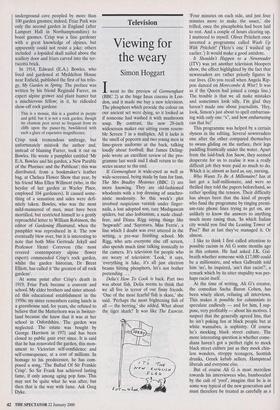Gardens
Frank's fame
Ursula Buchan
These have not been good times for the famous. Many a VIP must have rued the day they were flattered into leaving their fireside to pass the last evening of the old century in the Dome since, in the end, they spent most of it in a queue in a draughty Underground station. And, to cap it all, they were later dismissed as 'toffee-nosed' and 'snobby' (the ultimate indignity for chaps like Greg Dyke, surely?) by a minis- ter of the Crown. On the first Sunday of the year, the Archbishop of Canterbury took the Sermon on the Mount as his text, a passage in the Bible guaranteed to make any VIP squirm. Some days earlier, George Harrison, a man who long ago recognised that fame amounted to dust and ashes, and took himself off to enjoy a relatively private life, was stabbed at his home, Friar Park near Henley-on-Thames. Who said fame is as evanescent as a bubble? For George Harrison, it has proved all too enduring. Interestingly, Harrison is not the first famous person to have lived at Friar Park. Garden historians will tell you that the • builder of the house and garden was a rich Victorian swell, whose name became wide- ly known, in horticultural circles at least, as a result of the so-called Crispian Row. Sir Frank Crisp was a City solicitor of standing and influence, a generous man to his friends, and a strong adherent of Anglo-Catholicism. He commissioned the 120-room Friar Park in the Gothic Revival style in 1896. The enormous garden was divided up into a number of nostalgic, peri- od elements: there was, inter alia, an Eliza- bethan-style garden, a Dutch garden, a herb and `nosegaie' garden with plants cho- sen from 16th-century sources, a `Boccacio' garden, and a 'Mary' garden based on plants named after the Virgin Mary. But its most splendiferous element was the 30- foot-tall scale model of the Matterhorn, which rose from the top of the four-acre (!) rock garden, with a summit of alabaster to look like snow, and complete with model cast-iron chamois. This rock garden had an underground cave peopled by more than 100 garden gnomes; indeed, Friar Park was only the second garden in England (after Lamport Hall in Northamptonshire) to boast gnomes. Crisp was a fine gardener with a great knowledge of alpines, but apparently could not resist a joke: others included a lopsided skull nailed above the scullery door and friars carved into the ter- racotta brick.
In 1914, Edward (E.A.) Bowles, who lived and gardened at Myddelton House near Enfield, published the first of his trilo- gy, My Garden in Spring. The preface was written by his friend Reginald Farrer, an expert alpine grower and plant hunter but a mischievous fellow; in it, he ridiculed show-off rock gardens:
This is a mosaic, this is a gambol in purple and gold; but it is not a rock garden, though tin chamois peer never so frequent from its cliffs upon the passer-by, bewildered with such a glare of expensive magnificence.
Crisp took tremendous umbrage, but unfortunately mistook the author and, instead of blaming Farrer, took it out on Bowles. He wrote a pamphlet entitled 'Mr E.A. Bowles and his garden, a New Parable of the Pharisee and the Publican'; this was distributed, from a bookmaker's leather bag, at Chelsea Flower Show that year, by his friend Miss Ellen Willmott (who, in the heyday of her garden at Warley Place, employed 104 gardeners). It caused some- thing of a sensation and sides were defi- nitely taken. Bowles, who was the most mild-mannered of men, must have been mortified, but restricted himself to a gently reproachful letter to William Robinson, the editor of Gardening Illustrated, when the pamphlet was reproduced in it. The row eventually blew over, but it is interesting to note that both Miss Gertrude Jekyll and Professor Henri Correvon (the most revered contemporary alpine flower expert) commended Crisp's rock garden, whilst the garden historian, Dr Brent Elliott, has called it 'the greatest of all rock gardens'.
At some point after Crisp's death in 1919, Friar Park became a convent and school. My elder brothers and sister attend- ed this educational establishment in the 1950s; my sister remembers eating lunch in a greenhouse and, for years, she refused to believe that the Matterhorn was in Switzer- land because she knew that it was at her school in Oxfordshire. The garden was neglected. The estate was bought by George Harrison in 1971 and has been closed to public gaze ever since. It is said that he has renovated the garden, this mon- ument to Victorian self-confidence and self-consequence, at a cost of millions. In homage to his predecessor, he has com- posed a song, 'The Ballad Of Sir Frankie Crisp'. So Sir Frank has achieved lasting fame, if only among aging pop fans. This may not be quite what he was after, but then that is the way with fame. Ask Greg Dyke.



























































 Previous page
Previous page